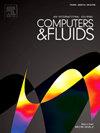On correctly evaluating orders of truncation error for node-centered edge-based schemes
IF 2.5
3区 工程技术
Q3 COMPUTER SCIENCE, INTERDISCIPLINARY APPLICATIONS
引用次数: 0
Abstract
In this short note, we present a simple analysis to show that an observed order of truncation error on a regular grid can change, if not correctly evaluated, depending on the choice of the norm and also on the discretization scheme. For a second-order scheme, it can be first order, second order, or anywhere in between. Using the node-centered edge-based discretization as an example, we provide a guide on how to evaluate the order of truncation error correctly: one should evaluate it separately for a set of nodes, where the residual stencil is symmetric and the same at every node, and the rest of nodes.
关于正确评估基于节点中心边缘方案的截断误差阶数
在这篇短文中,我们通过一个简单的分析表明,在常规网格上观察到的截断误差阶数,如果没有得到正确的评估,会随着规范的选择和离散化方案的不同而发生变化。对于二阶方案,它可以是一阶、二阶或介于两者之间的任何一阶。以以节点为中心的基于边缘的离散化为例,我们为如何正确评估截断误差的阶数提供了指导:我们应该分别评估一组节点和其他节点的截断误差,前者的残余模版是对称的,并且在每个节点上都是相同的。
本文章由计算机程序翻译,如有差异,请以英文原文为准。
求助全文
约1分钟内获得全文
求助全文
来源期刊

Computers & Fluids
物理-计算机:跨学科应用
CiteScore
5.30
自引率
7.10%
发文量
242
审稿时长
10.8 months
期刊介绍:
Computers & Fluids is multidisciplinary. The term ''fluid'' is interpreted in the broadest sense. Hydro- and aerodynamics, high-speed and physical gas dynamics, turbulence and flow stability, multiphase flow, rheology, tribology and fluid-structure interaction are all of interest, provided that computer technique plays a significant role in the associated studies or design methodology.
 求助内容:
求助内容: 应助结果提醒方式:
应助结果提醒方式:


